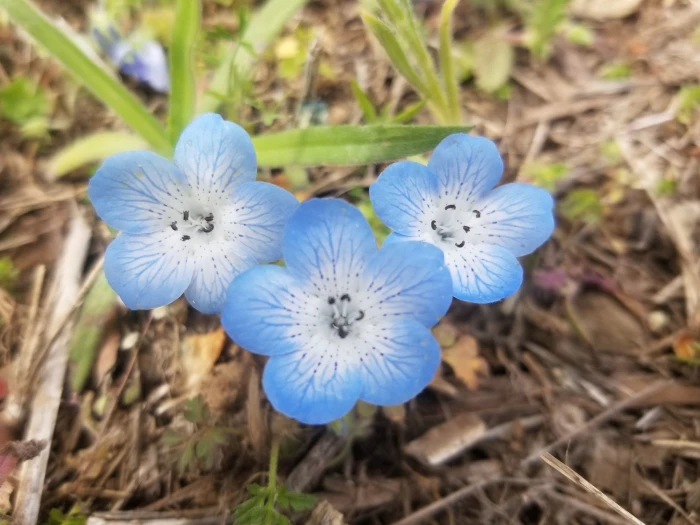Baby Blue Eyes
(Nemophila menziesii)
Baby Blue Eyes (Nemophila menziesii)
/
/

Jonathan Curley
CC BY 4.0
Image By:
Jonathan Curley
Recorded By:
Copyright:
CC BY 4.0
Copyright Notice:
Photo by: Jonathan Curley | License Type: CC BY 4.0 | License URL: http://creativecommons.org/licenses/by/4.0/ | Rights Holder: Jonathan Curley | Publisher: iNaturalist | Date Created: 2020-03-27T13:39:29-07:00 |























































Estimated Native Range
Climate Requirements for Fruit Cove, Florida
| This Plant | Your Site | Plant Suitability for Your Location | ||
|---|---|---|---|---|
| • Precipitation | 4" - 104" | 50" | Aquatic | Aquatic |
| • High Temp. | 58°F - 109°F | 90°F | Your summer temperatures are normal for this plant. | Excellent |
| • Low Temp. | -18°F - 48°F | 45°F | Your winter temperatures are normal for this plant | Excellent |
This plant may not grow well at your location - your precipitation is too high.
Summary
Nemophila menziesii, commonly known as Baby Blue Eyes, is an annual herb that is native to California, where it thrives in a variety of habitats including open woodlands, forest clearings, and chaparral regions. This plant is highly variable in appearance, typically growing to a height of 6 to 12 inches (15 to 30 centimeters) with a similar spread. The flowers of Baby Blue Eyes are its most striking feature, presenting a delicate blue hue with a white center, often adorned with blue veins and black dots near the center. The blooms are about 0.2 to 1.6 inches (6 to 40 millimeters) wide, appearing in the spring and early summer, and are known for their showy, cup-shaped form.
Gardeners appreciate Baby Blue Eyes for its charming flowers and its ability to attract pollinators such as bees and butterflies. It is commonly used in native plant gardens, water-conserving landscapes, traditional flower beds, and wildlife gardens for its ornamental value and ease of maintenance. Baby Blue Eyes prefers full sun to part shade and requires moderate watering, thriving in well-drained soils. While it is not known for serious pest or disease problems, it can self-seed prolifically under ideal conditions. Due to its potential to naturalize, gardeners should be cautious about planting it outside its native range, as it may become invasive in some regions.CC BY-SA 4.0
Gardeners appreciate Baby Blue Eyes for its charming flowers and its ability to attract pollinators such as bees and butterflies. It is commonly used in native plant gardens, water-conserving landscapes, traditional flower beds, and wildlife gardens for its ornamental value and ease of maintenance. Baby Blue Eyes prefers full sun to part shade and requires moderate watering, thriving in well-drained soils. While it is not known for serious pest or disease problems, it can self-seed prolifically under ideal conditions. Due to its potential to naturalize, gardeners should be cautious about planting it outside its native range, as it may become invasive in some regions.CC BY-SA 4.0
Plant Description
- Plant Type: Herb
- Height: 0.3-0.5 feet
- Width: 0.5-1 feet
- Growth Rate: Moderate
- Flower Color: Blue, White
- Flowering Season: Spring
- Leaf Retention:
Growth Requirements
- Sun: Full Sun, Part Shade
- Water: Medium
- Drainage: Medium
Common Uses
Bee Garden, Bird Garden, Border Plant, Butterfly Garden, Deer Resistant, Drought Tolerant, Groundcover, Low Maintenance, Potted Plant, Rock Garden, Showy Flowers
Natural Habitat
Native to open woodlands, forest clearings, and chaparral regions in California
Other Names
Common Names: Baby Blue-Eyes, Baby’s-Blue-Eyes, California Bluebell, Blaue Hainblume, Prins Gustafs Öga
Scientific Names: Nemophila menziesii, Nemophila insignis, Nemophila menziesii var. discoidalis, Nemophila discoidalis, Nemophila menziesii var. menziesii, Nemophila menziesii subsp. menziesii, Nemophila liniflora, Nemophila erosa, Nemophila menziesii subsp. insignis
GBIF Accepted Name: Nemophila menziesii Hook. & Arn.